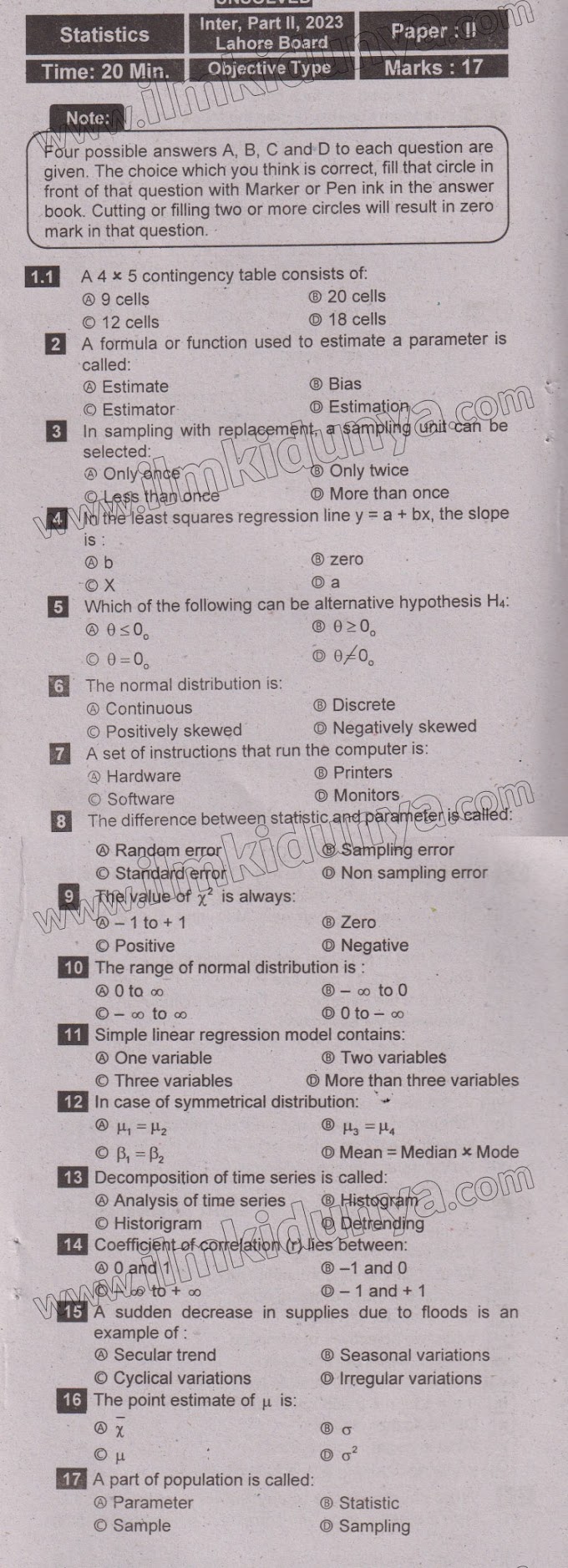Here you will see important short questions and important definitions of chapter 16 ANALYSIS OF TIME SERIES
Only request is to subscribe to this channel on youtube Welcome Academy for more videos about your paper.
12th class statistics chapter 16,ANALYSIS OF TIME SERIES,important definitions and short questions,2nd year class statistics
If you have any questions please leave a comment here,I will be very thankful to see your question.
#12thcalssstatistics #chapter16 #ANALYSISOFTIMESERIES#shortquestions #definitionitons @12thcalssstatistics @chapter16 @analysisoftimeseries @shortquestions @definitionitons #welcomeacademy123
Chapter 16: ANALYSIS OF TIME SERIES
These are very important question according to paper pattern.
Short Questions
Write short answers to the following questions.
Q.1 Define the term time series.
Ans.A time series is a sequence of observations, on variable, recorded in accordance with their time of occurrence.
Q.2 Difference between signal and noise in time series.
Ans.The signal is is a systematic component of variation in time series whereas the noise is an irregular component of variation in a time series.
Q.3What do you mean by Historigram?
Ans.A Historigram is a graphic representation of a time series that reveals the changes occurred at different time periods. OR A graph of time series data is known as Historigram.
Q.4 What are basic component of time series?
Ans.The four basic components of time series data are: (i) Secular Trend
(ii) Seasonal variation
(iii) Cyclic variation
(iv) Irregular variation
Q.5 Explain function of time series.
Ans.Let y1, y2,y3, ……, yn be the n observations of a variable Y, recorded in accordance with their time of occurrence t1, t2, t3, ….., tn, then the variable Y can be expressed as a function of time. Y = f(t) + e
Q.6 Define secular trend.
Ans.The secular trend is a line or curve that shows the general increase or decrease in a sequence of observations and reflects the effect of the forces operating over a long period of time. (OR) Secular trend in time series is a long term, smooth, steady, underlying pattern of change from time to time in the series.
Q.7 Define Seasonal variation.
Ans.Seasonal variation is the repetitive pattern of variation occurring within a year in a time series.
Q.8 Define Cyclic variation.
Ans. The cyclical variation of a time series is the wavelike pattern about the trend that is attributable to business and economic conditions at the time. It is also known as a business cycle.
Q.9 Define Irregular variation.
Ans. The irregular movements are unpredictable change that indicate the effect of random events such as wars, floods, strikes, fire, earthquake etc.
Q.10 Define analysis of time series.
Ans. The analysis of time series is the decomposition of a time series into its different components for their separate study.
Q.11 Write the multiplicative and additive models of analysis of time series.
Ans.Multiplicative model is Y = TSCI
Additive model is Y = T + S + C + I
Q.12 Define smoothing of time series.
Ans.The smoothing of time series is a process of eliminating the unwanted fluctuations in a time series.
Q.13 Define the principle of least square.
Ans. The principle of least square says that “sum of squares of the deviations of the observed values from the corresponding expected values should be least”.
Q.14 Define residual.
Ans. Residual is the difference between the actual value of the time series and the forecast value. It is also called the forecast error.
Q.15 Define forecasting.
Ans. The process of predicting the magnitude that a variable will assume in future is called forecasting.











0 Comments
Thanks for message us We shall approve it if you have oxygen like words for us